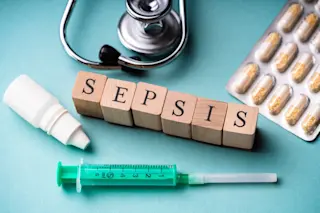Sepsis is a severe inflammatory response to infection. Infections of the lungs (such as pneumonia), bladder, digestive system or kidney are common precipitating factors. According to the Centers for Disease Control (CDC), more than 1.7 million adults develop sepsis each year in the United States — which equates to a diagnosis every 20 seconds.
It is the most common cause of death in hospitals, with one in three hospital patients dying due to sepsis. Let’s take a look at this serious health crisis and learn how to recognize it before it is too late.
Is Sepsis Contagious?
Sepsis itself is not contagious. However, some of the underlying infections that cause sepsis can be contagious. Most of them are bacterial, although there are also some viral and fungal infections that can lead to sepsis.
Because sepsis is a chain reaction immune response throughout the body, certain people are more susceptible to it during the time they are fighting an infection.
Recognizing Sepsis
The risk factors that increase the likelihood of developing sepsis include having a weakened immune system, being over 65 or under age 1, having undergone recent antibiotic treatment, taking corticosteroids, the use of catheters or breathing tubes, certain chronic diseases (kidney disease, COPD and diabetes) and being in an ICU.
An acronym that is used to recognize sepsis is TIME: temperature change, infection, mental status change and extremely ill.
Mild sepsis is largely survivable when identified quickly and treated with antibiotics and fluids. Many people make a full recovery from mild sepsis, but it takes an average of 3 to 10 days. In cases of severe sepsis, critical care treatments can last a month or longer.
Read More: The History of the Polio Vaccine
The Stages of Sepsis
There are three stages of sepsis. Although it is possible for sepsis to start slowly, more often than not, it will progress quickly. In fact, it is possible for the progression from infection to septic shock to occur in less than 24 hours. The stages of sepsis are as follows:
1. Sepsis
Stage one is referred to as Systemic Inflammatory Response Syndrome (SIRS). While it may be difficult to recognize, if two out of the three factors below are present, a sepsis diagnosis may be considered.
Body temperature of greater than 100.4 degrees F or less than 96.8 degrees F
Heart rate faster than 90 beats per minute
Breathing rate of more than 20 breaths per minute
Suspected or confirmed infection (based on white blood cell count)
2. Severe Sepsis
In the second stage, severe sepsis impacts the organs. It can affect any organ, including kidneys, lungs, liver or heart. Acute respiratory distress syndrome (ARDS) can develop during this stage.
Abnormal heartbeat
Difficulty breathing
Abnormal pain
3. Septic Shock
Septic Shock is the most serious form of sepsis and includes the presence of dangerously low blood pressure, despite intravenous fluid replacement. Symptoms also include:
Fast pulse
Difficulty breathing
Confusion or delirium
Decrease urine output
Increased levels of lactate in the blood
Read More: What Would Happen If We Didn’t Have Vaccines?
Life Expectancy After Sepsis
Sepsis is a serious, life-threatening condition, particularly when it has progressed to septic shock. Statistics vary regarding survival rates, but the earlier sepsis is identified and treated, the greater chance for survival.
There are people who survive septic shock, but survival rates are lower for the elderly. Among those who survive septic shock, recovery is difficult, and symptoms can persist for months or years.
Septic patients are treated in the ICU, and that can lead to post-intensive care syndrome, known as PICS. These patients’ lives are altered by ongoing physical, cognitive and emotional issues — including delirium.
Treating Sepsis
Critical care expert Dr. Wes Ely of Vanderbilt University developed a groundbreaking approach to reducing ICU patient harm that has been adopted by hospitals worldwide. He considers ICU (sepsis patients) related delirium to be an important health issue in need of greater attention.
It is possible to make a full recovery after severe sepsis. However, the best way to prevent the development of sepsis to septic shock is early recognition of symptoms and prompt treatment.
Read More: Could You Spot the Signs of a Stroke?















